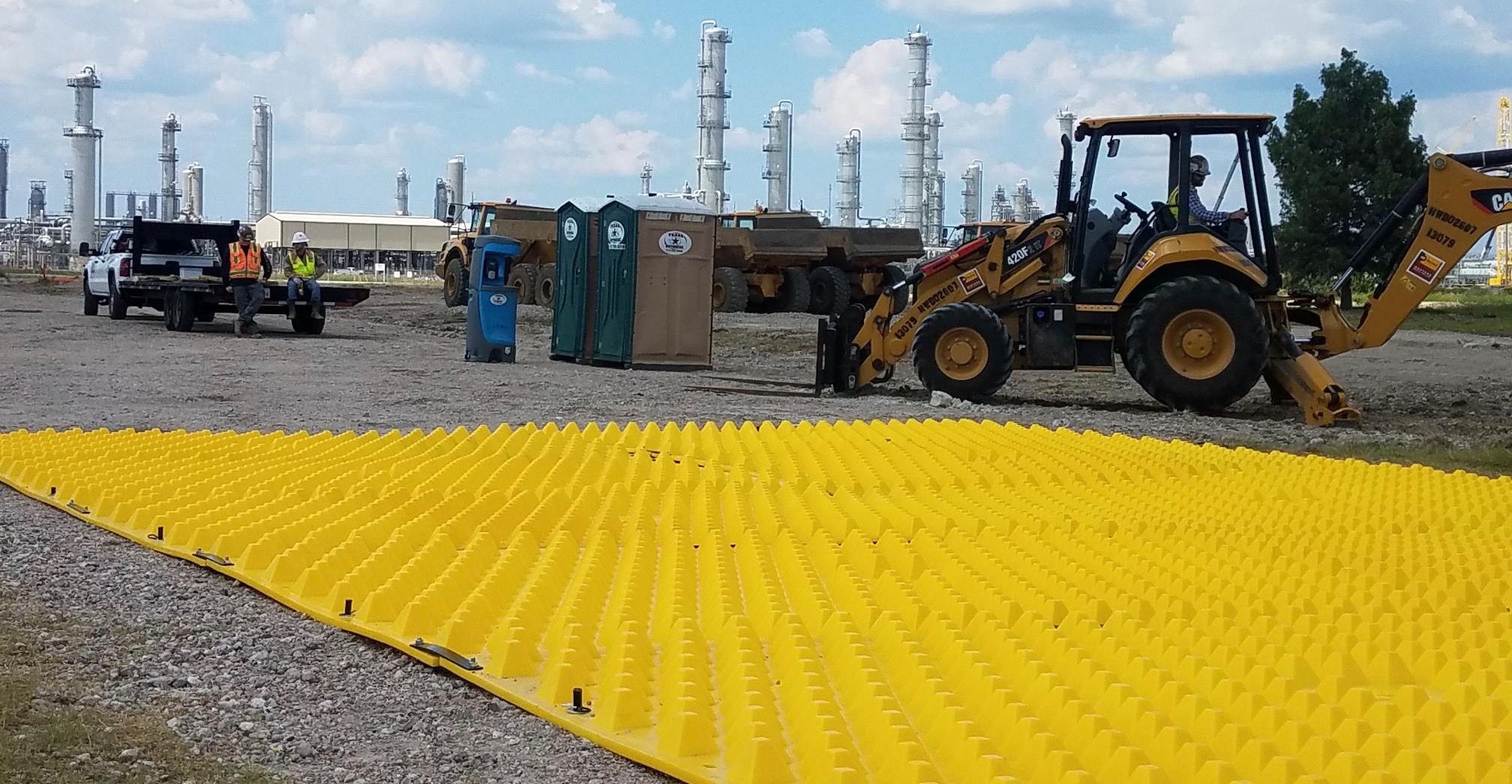Mississippi Stabilized Construction Entrance/Exit Detail
Mississippi is home to the second longest North American River which creates the state’s western border and gives the state its iconic name. The Mississippi River collects storm water runoff from 32 different states comprising the second largest drainage system at over 1.1 million square miles. Ecologically the Mississippi River serves as a migratory flyway for 60% of all North American waterfowl, and over 230 species of fish are present in its waters. The watershed from the state of Mississippi contributes to the great river as it runs into the Mississippi River Delta.
This area is also an important economical point for the nation as it is the hub for many large trade ports and the home of a vibrant ecological system. Major industries include fishing, hunting, boating and other recreational ventures contribute to nearly 21.4 billion dollars in revenue each year. The purity of the waters that flow into this indispensable river can drastically affect the health of its production both economically and ecologically. Consequently, the quality of Mississippi’s stormwater directly effects these areas of vital significance.
It is the responsibility of the residents, industries, and governments to form and uphold standards to protect and rehabilitate this resource. The Federal government began the Clean Water Act (CWA) in 1972 which addressed the abuse that industry and construction exerts on the surrounding stormwater system. This effort at mitigating contaminants has produced certain laws and permits that are required for specific activities. Most notable of these programs is the National Pollutant Discharge Elimination System (NPDES) which mandates a permit for any water discharges from municipal activity, industrial activity, as well as any construction activity affecting land one acre or more.
Mississippi Department of Environmental Quality (MDEQ) NPDES Stormwater Permits
The Mississippi Department of Environmental Quality (MDEQ) has been approved by the EPA to administer the NPDES permit program which involves both reviewing and enforcing the NPDES stormwater permit program. The department also provides information to contractors and engineers in the form of a Guidance Manual and Field Manual.
Many construction projects can be authorized under a General Permit. The General Permit for Construction Stormwater is split into two permits dependent on the size of the construction zone. The Small Construction General Permit covers any site between one and five acres. The Large Construction General Permit is required for any site disturbing more than five acres of land. These permits have differences but the general focus of both is similar. To obtain coverage under the General Permit, an operator must follow the provisions of the Permit and submit a Notice Of Intent (NOI) to inform the MDEQ of proposed activities. Other projects may require an Individual Permit which is reviewed on a case-by-case basis.
To be granted coverage under a General Stormwater Permit or to apply for an Individual Permit an operator will need to prepare and submit a Stormwater Pollution Prevention Plan (SWPPP). The SWPPP is a document which outlines all potential sources of pollution and sedimentation as well as specific methods which will be used to address the pollution. These methods are referred to as Best Management Practices, or BMPs, and include techniques to establish erosion control, dust control, and minimize construction sediment tracking. The Mississippi SWPPP Guidance Manual for Construction Activities includes examples, specific preparations, operations, and maintenance necessary to keep the site within the standards set by the state.
Construction Entrance/ExitS BMP
A construction entrance is one of the first BMPs to be installed by an operator when beginning a construction project. The purpose of a construction entrance/exit is to provide a stabilized area at entrance points to reduce sediment, mud, and other contaminants tracked onto public roadways. To ensure effective use of a construction entrance BMP, site traffic should be restricted to use only stabilized entrances.
A construction exit is preferably located on high ground to prevent sediment laden runoff from flowing into the street. An effective egress/ingress area will provide adequate drainage to direct runoff into a sediment basin to contain run off on-site. The substrate may need to be prepared before installation of the entrance which commonly includes excavation.
In addition to the entrance, street sweeping or scraping should be conducted on a regular basis to capture any debris or sediment that is deposited onto public roadways. The MDEQ Guidance Manual states that street sweeping should be conducted at the end of each day to prevent sediment from washing into storm drains. Construction entrances should be inspected regularly to ensure sufficient performance. If sediment is not sufficiently contained, the construction entrance is likely in need of maintenance or repair. If sediment is not sufficiently contained after repairs, another BMP may be required to increase sediment capture.
There are different techniques used to create construction entrances and each has its benefits and maintenance requirements.
Stone Stabilized Site Entrances
The most common type of construction entrance is the stone stabilized pad. This method uses large gravel to clean the tires of exiting construction vehicles. As vehicles drive through the aggregate pad the rough surface of the rocks works to loosen any soil clinging to the exiting vehicles’ tires. The Manual includes specifications for a stone construction site entrance with a minimum of 50’ in length and at least 6” in depth. The length of the entrance may need to be extended to provide adequate sediment containment. The stone or crushed rock required is DOT #1 Coarse Aggregate which is 1.5” – 3” diameter gravel. A geofabric filter fabric is also necessary to separate the stone pad from the native soil and must be applied before the gravel is introduced.
As vehicles drive over the stone pad, the rough surface can become flattened and soil can build between the voids in the rock. When the pad is compacted, soil containment is reduced, and the entrance must be repaired. Stone entrances are repaired by top dressing the pad with an additional layer of rock to restore surface roughness.
Tire Washing Station
Construction entrance aggregate pads are susceptible to falling below acceptable standards of performance due to factors such as soil density, high traffic volume, and rain events. If the operator has observed excessive sediment tracking onto public roadways it may be necessary to add a wash station to the ingress/egress zone. A Tire Washing Station is an area where a pressure washer operated by a laborer, or an automated pressure washer system, is used to clean any remaining sediment from the vehicles wheels after passing over the construction entrance and before entering the public roads. This system requires the site to have access to water and to set up a sediment trap to collect the used water.
Wheel wash stations also require maintenance. Many systems recycle the water and collect sediment which must be emptied periodically. In addition, the sediment basin and drainage paths may require repairs if water begins to spill outside of the sediment basin or onto the roadway.
FODS Trackout Control System
FODS Trackout Control System is an effective BMP for trackout control. The system is comprised of a single layer of HDPE matting which is formed into pyramids on the surface. The pyramids work to flex and deform tires in order to dislodge debris and sediment stuck between tire treads.
The FODS system is a durable product which can be reused on multiple projects. The mats can be reconfigured as needed and installed over dirt, concrete or asphalt. In addition, the system can be relocated on multiple phases on linear projects and significantly reduce the cost of construction entrance installation, maintenance, and removal.
The pyramids do not degrade from construction vehicle traffic, but will eventually become filled with sediement and require maintenance. The 3” tall pyramids can hold up to 2.5” of sediment as the tires only come into contact with the tips of the pyramids. Maintenance is commonly completed by using a street sweeper or a skid steer with broom attachment. In this way, contractors can simply drive over the mats during their daily street sweeping to maintain performance during the project.
The modular FODS system outperforms traditional stone stabilized construction entrances and is commonly specified at 50% of the length of a stone stabilized tracking pad. In addition, the system is both flexible and cost effective enabling contractors to reduce sedimentation and costs on each project the mats are used.
Additional Resources
Mississippi Erosion and Sediment Control Field Manual
Mississippi SWPPP Guidance Manual for Construction Activities

